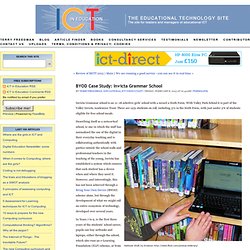

Bring Your Own Device. As computers have increased in power and decreased in cost and size, it has become possible for more and more students to bring their own computers into school.

However, the "computers" may not look like traditional boxes and screens. Today's smartphones, iPods, and tablets have more computing power than NASA's Mars Rover. It has become possible to use a personal device to perform the same research, computing, and content creation tasks that required a full-size desktop computer a few years ago. This shift has caused many schools, including Oregon, to allow students to bring in their own computing devices to support their learning. This is obviously very different from when most parents were in school, so it may seem a bit odd. Although students in any grade are allowed to bring devices, students at OMS and OHS are encouraged to bring their own Internet-ready computing devices to school to be used in their classwork. Equity We do not recommend smartphones for the following reasons: BYOD Case Study: Invicta Grammar School. Invicta Grammar school is an 11–18 selective girls’ school with a mixed a Sixth Form.

With Valley Park School it is part of the Valley Invicta Academies Trust. There are 1251 students on roll, including 371 in the Sixth Form, with just under 3% of students eligible for free school meals. Netbook Shelf, by Enokson itself as a networked school, ie one in which the staff has normalised the use of the digital in their everyday teaching and is collaborating authentically with parties outside the school walls and professional teachers in the teaching of the young, Invicta has established a system which ensures that each student has a device when and where they need it.
However, and interestingly, this has not been achieved through a Bring Your Own Device (BYOD) scheme alone, but through the development of what we might call an entire ecosystem of technology, developed over several years. In Years 10-13, students can bring in their own device. Carol Webb, Assistant Headteacher, explains: BYOT: the policy that dare not speak its name?
A couple of months ago Mike Sharples, a researcher at the Open University, told me that he had looked at the websites of some of the schools I was writing up case studies on in connection with their Bring Your Own Technology policy, but was unable to find any references to it whatsoever.

He came to the conclusion that: BYOT is the policy that dare not speak its name. Is BYOT a big secret for many schools? Image (c) Mike Licht, have to say that although there are quite a few schools adopting a BYOT approach, finding them has not been easy. In fact, I still haven’t quite worked out whether there are not that many of them as a percentage of all schools, or whether the ones that are doing it don’t want to say too much in case it all goes horribly wrong.
Last week I attended a half-day conference on the subject of Digital And Mobile Learning. Do you have an opinion on, or any knowledge of, this? And see the BYOT blog as well. BYOD (Bring Your Own Device) Toolbox.